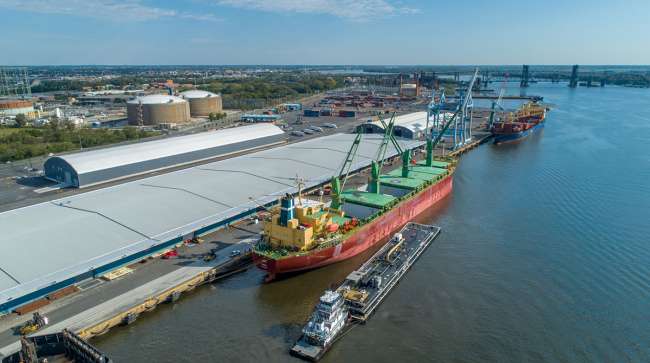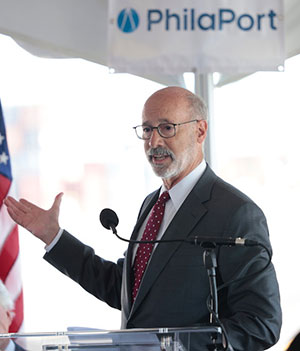Staff Reporter
PhilaPort Terminal Gets $20.3 Million Grant to Ease Truck Congestion

[Stay on top of transportation news: Get TTNews in your inbox.]
The Port of Philadelphia will have less truck congestion and more capacity thanks to a $20.3 million federal infrastructure grant award.
“We receive calls daily from shippers looking for dry storage. With the construction of a new 100,000-square-foot warehouse, we will have the ability to attract new business, that will result in the creation of additional family-sustaining jobs for the region,” said Jeff Theobald, executive director and CEO of the Philadelphia Regional Port Authority (PhilaPort).
PhilaPort is the largest refrigerated port in the nation and top fruit gateway for the country. It also is a leading North American port of entry for meat and dairy products.
I joined @GovernorTomWolf at @PhilaPort to celebrate the latest influx of funding—largely from @POTUS's infrastructure law—that will be used to build a new 100,000 sq. ft. warehouse at the Tioga Marine Terminal. pic.twitter.com/AHsOHSXW0E — Senator Bob Casey (@SenBobCasey) October 14, 2022
“The port is an economic powerhouse not just for the Philadelphia region, but for all of Pennsylvania,” said Gov. Tom Wolf. “This is a major hub for global trade and a crucial link in the supply chain for the goods that Pennsylvanians use every single day.”
It serves Atlantic Ocean vessels and transfers bulk raw materials and finished products in containers. River barge traffic handles mostly large volumes of dry bulk materials for the metal, chemical and energy industries.
Theobald recently joined Wolf and Sen. Bob Casey (D-Pa.) to celebrate the federal dollars for the port’s Tioga Marine Terminal project, developed through a collaboration with Delaware River Stevedores, which operates Tioga terminal.
The new warehouse at Tioga terminal will have rail access, employee parking and loading docks. Other features include relocating and building a new modernized gate complex and maintenance facility. Construction is to start in 2024.

Wolf at the Port of Philadelphia. (Office of Gov. Tom Wolf)
“Safety of our labor force is paramount. With a modernized gate and approach to the terminal we can ensure that both the port and public are protected as the port continues to grow,” Jerry Sweeney, PhilaPort board of directors chair, said when the grant was announced.
Upon completion, Tioga Marine Terminal, which is experiencing higher demand for pulp, project cargoes, steel and lumber products, will have more than 800,000 square feet of on-dock warehousing.
Calling PhilaPort a critical part of the U.S. supply chain, Casey noted that “by moving commerce through this region, these waterways create and sustain good-paying union jobs and spur economic growth.”
The U.S. Department of Transportation’s Infrastructure for Rebuilding America grant was awarded Sept. 15 to PhilaPort, an independent state agency tasked with managing port facilities along the Delaware River in Pennsylvania and port district strategic planning.
INFRA grants are for nationally significant multimodal freight and highway projects. In its award notice, DOT stated that the Tioga terminal project will help address lack of capacity and avoid lengthy cargo rerouting to other East Coast ports.
“The project reduces truck congestion and idling at the port, which will facilitate the movement of goods, improve air quality and reduce greenhouse gas emissions in the nearby underserved communities,” DOT stated.
According to the port, current truck turn times at the port are under 40 minutes. Interstate 95 is next to port facilities, and I-76 (a major east-west artery) has entrance ramps close to PhilaPort terminals.
“With this grant PhilaPort is able to meet the demands of the current market and add much-needed capacity in the warehouse space,” Theobald said.
Spanning 116 acres, the Tioga terminal has six berths and handles wood, steel, containers, over-dimensional, palletized, project and breakbulk cargo. Loading docks have canopied loading platforms for 100 trucks.
According to the state Department of Transportation’s September draft of its 2045 freight plan, PennDOT expects PhilaPort to be impacted by a growing national trend for more container-on-barge transportation, since containers can be easily transferred for final delivery to truck or rail.
PennDOT noted that at PhilaPort “a portion of fruit and cocoa bean cargo has transitioned from breakbulk to container, shifting the need and location of appropriate terminal and storage facilities.”
Want more news? Listen to today's daily briefing below or go here for more info:


